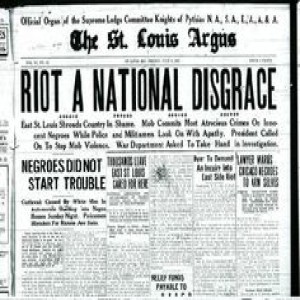
On this day in labor history, the year was 1917.
That was the day known as the East St. Louis Race Riot.
It is considered the worst case of labor–related violence of the 20th century and one of the worst race riots in American history.
At the time, East St. Louis, Illinois was an industrial hub along the Mississippi River, across from St. Louis, Missouri.
Production demands for World War I intensified the Great Migration.
As African-Americans emigrated from the South, filling the demand for industrial labor, tensions grew at workplaces and in the communities in which they settled.
That spring, black and white workers had been hired to scab on a local strike.
The violence began on May 28, when trade unionists marched to the mayor’s office, protesting the black labor they considered ‘unfair competition.’
It quickly turned into an anti-black riot.
The National Guard was called out to quell the violence.
Then on this day, two days of rioting began when a car of white men drove through a black neighborhood and fired at a group of blacks.
Racist mobs killed as many as 200 African-Americans.
6000 more were left homeless.
Many remarked bitterly that the police and National Guard stood by, indifferent to the race violence around them.
The President of the Illinois Federation of Labor insisted that employers were to blame for using Southern blacks to break the back of labor.
Socialist Party leader Eugene V. Debs declared the riots were “a foul blot upon the labor movement.”
Debs continued, “Had the labor movement freely opened their doors to the Negro instead of barring him, the atrocious crime of East St. Louis would never have blackened the pages of American History.”
More Episodes
 2024-02-29
2024-02-29
 2024-02-27
2024-02-27
 2024-02-26
2024-02-26
 2024-02-24
2024-02-24
 2024-02-20
2024-02-20
 2024-02-18
2024-02-18
 2024-02-17
2024-02-17
 2024-02-17
2024-02-17
 2024-02-13
2024-02-13
 2024-02-10
2024-02-10
Create your
podcast in
minutes
- Full-featured podcast site
- Unlimited storage and bandwidth
- Comprehensive podcast stats
- Distribute to Apple Podcasts, Spotify, and more
- Make money with your podcast
It is Free
- Privacy Policy
- Cookie Policy
- Terms of Use
- Consent Preferences
- Copyright © 2015-2024 Podbean.com




